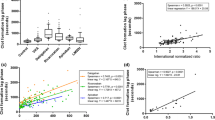Abstract
The haemostatic profile of 46 healthy, adult female llamas was evaluated and compared to a human reference plasma. The results indicate that standard laboratory reagents and procedures are suitable for the determination of procoagulant, anticoagulant and fibrinolytic analytes in llama plasma. Human recombinant tissue factor is an effective reagent for the prothrombin time assay. With this reagent, llama plasma exhibited a clotting time similar to human reference plasma. The activated partial thromboplastin time results were shorter for llama plasma than for human plasma, and there was a significant (p<0.05) increase, in the order of tenfold, in factor VIII:C activity when human plasma was used as the reference standard. The activities of other procoagulant proteins, including factor VII, IX, X and Xl, were similar irrespective of whether llama or human reference standards were used.
The anticoagulant or inhibitory activity, as determined by the amounts of α2-macroglobulin and antithrombin, the fibrinolytic activity, as estimated from the levels of plasminogen and plasminogen activators, as well as fibrinogen values are consistent with those reported for other domestic species such as the horse.
Similar content being viewed by others
References
Beresford CH, Owen MC (1990) Antithrombin III. Int J Biochem 22:121–128
Broze GJ, Gailani D (1993) The role of factor X1 in coagulation. Thromb Haemost 70:72–74
Davie EW, Fujikawa K, Kisiel W (1991) The coagulation cascade: initiation, maintenance, and regulation. Biochemistry 30:10363–10370
Dodds WJ (1989) Hemostasis. In: Kaneko JJ (ed) Clinical biochemistry of domestic animals. Academic Press, New York, pp 274–315
Fowler M (1989) Multisystem disorders. In: Medicine and surgery of South American camelids. Iowa University Press, Iowa, pp 166–175
Fowler ME (1994) Hyperthermia in llamas and alpacas. Vet Clin North Am Food Anim Pract 10:309–317
Fowler ME, Zinkl JG (1989) Reference ranges for hematologic and serum biochemical values in Llamas (Lama glama). Am J Vet Res 50:198–200
Francis CW, Marder VJ, Barlow GH (1980) Plasmic degradation of cross-linked fibrin. J Clin Invest 66:1033–1043
Garry F (1989) Clinical pathology of llamas. Vet Clin North Am Food Anim Pract 5:55–70
Garry F (1993) Assessment of colic in llamas. In: Proc 11th Ann Vet Med Forum, Washington, DC, pp 817–820
Gentry PA, Cooper ML (1979) Reagent dependent variability of feline plasma clotting times. Feline Pract 9:33–37
Gentry PA, Ross ML (1986) Failure of routine coagulation screening tests to detect the heterozygous state of bovine factor XI deficiency. Vet Clin Pathol 15:12–16
Gentry PA, Woodbury FR, Black WD (1978) Comparative study of blood coagulation tests in the horse and pony. Am J Vet Res 39:333–336
Gentry PA, Feldman BF, O'Neill SL et al. (1992a) Evaluation of the hemostatic profile in the pre- and post parturient mare, with particular reference on the perinatal period. Equine Vet J 24:33–36
Gentry PA, Feldman BF, O'Neill SL (1992b) An evaluation of the effect of reagent modification on routine laboratory coagulation tests. Equine Vet J 24:30–32
Greene CE, Tsang VCW, Prestwood AK et al. (1981) Coagulation studies of plasmas from healthy domesticated animals and persons. Am J Vet Res 42:2170–2177
Hemker HC, Kessels H (1991) Feedback mechanisms in coagulation. Haemostasis 21:189–196
Hussein MF, Al-Momen AK, Gader AMA (1992) Haemostatic parameters in the camel (Camelus dromedarius): comparison with humans. Comp Haematol Int 2:92–96
Lehwald-Van Voorst NAM (1993) Protein profile of bovine follicular fluid and the synthesis of fibronectin by bovine granulosa cells. MSc Thesis, University of Guelph
Lewis JH (1976) Comparative hematology — studies on camelidae. Comp Biochem Physiol 55A:367–371
Morin DE, Garry FB, Weiser MG (1993) Hematologic responses in llamas with experimentally-induced iron deficiency anemia. Vet Clin Pathol 22:81–86
Mulrooney DM, Johnson MR, Smith BB et al. (1989) Clinical reference values for serum protein electrophoresis for the llama (Lama glama). Am J Vet Res 50:1889–1892
Mussoni L, Raczka E, Chmielewska J et al. (1979) Plasminogen assay in rabbit, rat and mouse plasma using the chromogenic substrate S2251. Thromb Res 15:341–349
Nemerson Y (1992) The tissue factor pathway of blood coagulation. Semin Hematol 29:170–176
Pannell R, Black J, Gurewich V (1988) Complementary modes of action of tissue-type plasminogen activator and pro-urokinase by which their synergistic effect on clot lysis may be explained. J Clin Invest 81:853–859
Pizzo SV (1994) The physiological role of antithrombin III as an anticoagulant. Semin Hematol 31:4–7
Smith JA (1989) Noninfectious, metabolic, toxic, and neoplastic diseases of camelids. Vet Clin North Am Food Anim Pract 5:114–115
Van Houten D, Weiser MG, Johnson L et al. (1992) Reference hematologic values and morphologic features of blood cells in healthy adult llamas. Am J Vet Res 53:1773–1775
Wachtfogel YT, DeLa Cadena RA, Colman RW (1993) Structural biology, cellular interactions and pathophysiology of the contact system. Thromb Res 27:1–21
Winder NC, Pellegrinin A, Von Fellenberg R (1993) Immunohistochemical location of α2-macroglobulin in the horse. Res Vet Sci 47:393–396
Yamada M, Gentry PA (1995) The hemostatic profie of equine ovarian follicular fluid Thromb Res 77:45–54
Zareie M (1994) Protein profile of equine follicular fluid. MSc thesis, University of Guelph
Author information
Authors and Affiliations
Rights and permissions
About this article
Cite this article
Morin, D.E., Yamada, M. & Gentry, P.A. Procoagulant, anticoagulant and fibrinolytic activities in llama plasma. Comparative Haematology International 5, 125–129 (1995). https://doi.org/10.1007/BF00638931
Issue Date:
DOI: https://doi.org/10.1007/BF00638931




